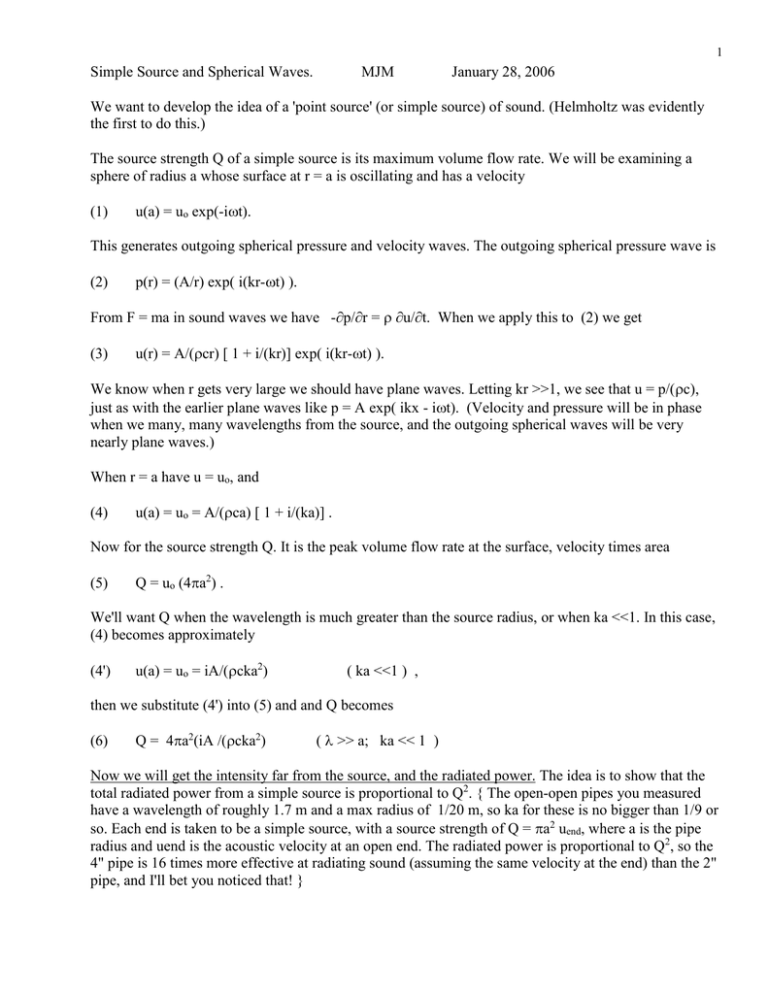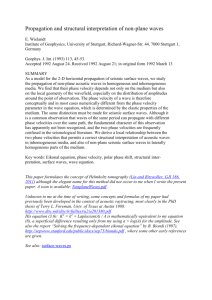Simple Source and Spherical Waves. MJM January 28, 2006
advertisement

1
Simple Source and Spherical Waves.
MJM
January 28, 2006
We want to develop the idea of a 'point source' (or simple source) of sound. (Helmholtz was evidently
the first to do this.)
The source strength Q of a simple source is its maximum volume flow rate. We will be examining a
sphere of radius a whose surface at r = a is oscillating and has a velocity
(1)
u(a) = uo exp(-it).
This generates outgoing spherical pressure and velocity waves. The outgoing spherical pressure wave is
(2)
p(r) = (A/r) exp( i(kr-t) ).
From F = ma in sound waves we have -p/r = u/t. When we apply this to (2) we get
(3)
u(r) = A/(cr) [ 1 + i/(kr)] exp( i(kr-t) ).
We know when r gets very large we should have plane waves. Letting kr >>1, we see that u = p/(c),
just as with the earlier plane waves like p = A exp( ikx - it). (Velocity and pressure will be in phase
when we many, many wavelengths from the source, and the outgoing spherical waves will be very
nearly plane waves.)
When r = a have u = uo, and
(4)
u(a) = uo = A/(ca) [ 1 + i/(ka)] .
Now for the source strength Q. It is the peak volume flow rate at the surface, velocity times area
(5)
Q = uo (4a2) .
We'll want Q when the wavelength is much greater than the source radius, or when ka <<1. In this case,
(4) becomes approximately
(4')
u(a) = uo = iA/(cka2)
( ka <<1 ) ,
then we substitute (4') into (5) and and Q becomes
(6)
Q = 4a2(iA /(cka2)
( >> a; ka << 1 )
Now we will get the intensity far from the source, and the radiated power. The idea is to show that the
total radiated power from a simple source is proportional to Q2. { The open-open pipes you measured
have a wavelength of roughly 1.7 m and a max radius of 1/20 m, so ka for these is no bigger than 1/9 or
so. Each end is taken to be a simple source, with a source strength of Q = a2 uend, where a is the pipe
radius and uend is the acoustic velocity at an open end. The radiated power is proportional to Q2, so the
4" pipe is 16 times more effective at radiating sound (assuming the same velocity at the end) than the 2"
pipe, and I'll bet you noticed that! }
2
We showed earlier that intensity <I> = 1/2 Re(pu*), where * is the complex conjugate. Applying this to
Eqs (2) and (3) gives us
(7)
<I> = |A|2/ (2 c r2) Re (1 - i/(kr)) .
Far from the source, kr >> 1 and we have <I> = |A|2/ (2 c r2) . The average total power radiated is the
intensity times the area of a sphere (4r2)
(8)
<P> = P = 2 |A|2 /(2c).
We want this in terms of the source strength Q, so we substitute for A from (6)
(9)
P = [ 2 /(2c) ] |ck Q/(i 4) |2 .
This simplifies to
(10)
P = c k2 Q2/(8)
[Avg power radiated; ka << 1; See Eq 8.18. p 230 ]
This is time averaged radiated power from a simple source at relatively low frequencies where >> a
and ka <<1. Q is the 'source strength', the peak volume flow rate (basically the integral of velocity over
area, or velocity times area if u is constant).
That's a big reason why large area pipes or instruments put out a lot of acoustic power. {But it doesn't
explain why bagpipes are so loud, unless a very large acoustic velocity makes up for a fairly small area.}


